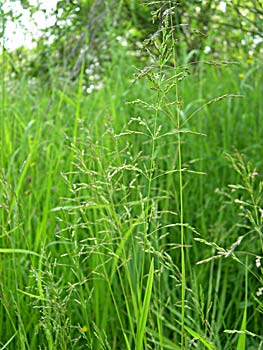Relatives
Poa palustris L. - Fowl bluegrass.
Systematic position.
Family Poaceae Barnhart, genus Poa L.Synonyms.
P. janczewskii Zapal., P. rotundata Trin., P. serotina Ehr. Ex Gaudin, P. stricula Steud.Morphology and biology.
Perennial, loose-tussock grass. Height reaches 25-90 (120) cm. Stem is smooth; upper node is located in the upper part. Leaf is 1-4 mm wide, flat, soft; usually leaf is longer than the sheath. Lingula of upper leaf is 2-3 mm long. Inflorescence is a loose panicle with long, rough branches. Spikelet is 3-5 mm long with bare axis. Lower floral glume has downiness on carina and along veins. Callus has several long, twisting hairs. Plant is cross-pollinated and wind-pollinated. Flowering and ripening occurs in July-August. Plant undergoes seed and vegetative reproduction. Chromosomal number 2n=28, 42.Distribution.
Occurs throughout the European part of the former USSR, Caucasia, Western and Eastern Siberia (except the Arctic), the Far East, Middle Asia (southeastern part), Scandinavia, Atlantic and Central Europe, the Mediterranean, Asia Minor, Iran (north), the Himalayas (west), Mongolia, Japan, China, and North America. It occurs as an invasive species in additional countries.Ecology.
Occurs in meadows, in bogs, in light forests, near river sands, and along roads up to the upper mountain zone.Economic value.
Forage.Reference citations:
Cherepanov S.K. 1995. Plantae Vasculares Rossicae et Civitatum Collimitanearum (in limics USSR olim) [List of Vascular Plants of Russia]. St. Petersburg: Mir I Semia. 990 pp. (In Russian)Malyshev L.I., Peshkova G.A., eds. 1990. Flora of Siberia. Vol. 2. Novosibirsk: Nauka, 361 pp. (in Russian).
Tzvelev N.N. 1976. Poaceae USSR. L.: Nauka, 788 pp. (in Russian).


